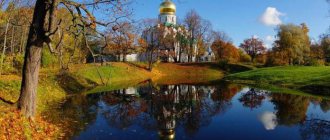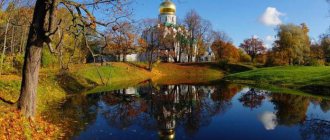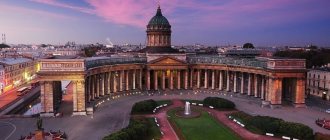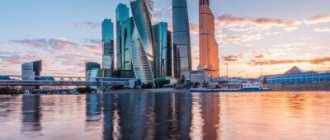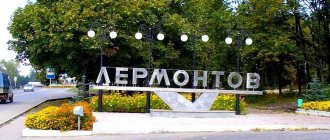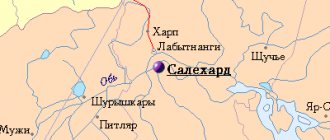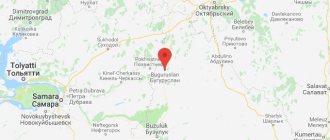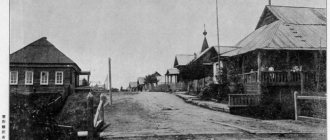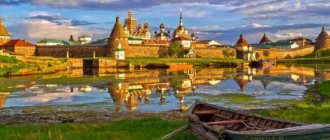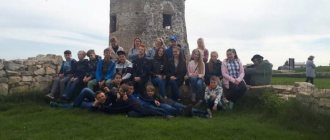> Countries Russia St. Petersburg
Pushkin is one of the most picturesque suburbs of St. Petersburg. Historical and architectural monuments of the 18th century and residential buildings of the 19th century are well preserved here. It includes the famous Tsarskoe Selo museum-reserve with picturesque parks, luxurious palaces and unusual pavilions. This is a great travel destination where you can see the center in one day, as well as admire nature or immerse yourself in the rich history of these places.
- In the center
- Neighborhood
- Excursions
- Map
The significance of the city of Pushkin in the modern world
The city of Pushkin is part of the district of the federal city of the same name called St. Petersburg and its intracity municipal formation.
Over the years, the settlement was called:
| Before 1710 | Sarskaya Manor |
| Before 1724 | Blagoveshchenskoe |
| Before 1780 | Sarskoe village |
| Before 1917 | Tsarskoye Selo |
| Before 1918 | Soldiers' Village |
| Before 1937 | Children's village named after Uritsky |
Currently, a public movement has been founded in the city, which advocates the return of the historical name “Tsarskoye Selo”.
The city is the largest tourist, scientific, educational and military-industrial center. The date of its foundation is 1710. The settlement received city status in 1808. Its total occupied area is 89,241 square meters. km.
Initially, the city was positioned as a country imperial residence. Subsequently, a museum was organized here. The iconic monument of urban planning art and the palace park complex (founded in the 18th-20th centuries) is called “Tsarskoe Selo”. It included the world famous Catherine Park, Catherine Palace and numerous other religious buildings.
The modern layout of the city was determined at the beginning of the 20th century. Pushkin has a clear layout and consists of 2 main parts: northeastern and southern.
The northeastern part of the settlement arose on the site of the Old Sloboda and has the main Cathedral Square on its territory. Almost all the streets of the district intersect at an angle of 90°; the oldest streets are called Sadovaya, Srednyaya and Malaya.
The southern part of the city is located on the site of the former city called Sofia and its center is Sofia Square.
The modern administrative division of the city into districts:
- Historical Center;
- Sofia;
- Krasnoselka;
- Friedenthal Colony;
- BAM;
- New village;
- Belozerka;
- Novoselki;
- Pavlovsk;
- Lesnoye;
- Kondakopshino;
- Novokondakopshino;
- Volkhonka.
Cameron Gallery
A wonderful masterpiece of architecture. The light gallery floating above the park invites you to take a walk and feel like a part of that era. Decorated with fabulous floral arrangements and sculptures. The gallery offers beautiful views of the park design and floral compositions. Here you can often find a whole line of newlyweds and for good reason - the place is enchanting.
Location: Sadovaya, 7a, Pushkin, St. Petersburg
Climate
The city of Pushkin is located in a humid and temperate climate zone, which is gradually transforming from marine to continental.
Over the years of meteorological observations, the following climatic conditions have been recorded in the city:
| Month | Day °C | Night °C | Comfort rating out of 5 |
| January | -5,3 | -9,4 | 2,5 |
| February | -3,6 | -8,3 | 2,5 |
| March | +0,2 | -5,2 | 4,2 |
| April | +7,8 | +0,5 | 4,2 |
| May | +16,3 | +6,5 | 4,6 |
| June | +19,1 | +9,7 | 4,8 |
| July | +23,2 | +13,4 | 5,0 |
| August | +21,0 | +12,3 | 5,0 |
| September | +15,4 | +8,5 | 4,5 |
| October | +7,1 | +2,8 | 4,2 |
| November | +2,3 | -0,6 | 4,2 |
| December | -2,1 | -5,3 | 2,5 |
According to the comfort rating, July and August are considered the most successful months for traveling to the city of Pushkino.
Average climate data in Pushkino:
| Month | Sunny days | Precipitation in mm | Wind speed in m/s | Rainy days |
| January | 2 | 20,23 | 3,3 | 2 |
| February | 0 | 24,45 | 3,3 | 4 |
| March | 4 | 16,37 | 3,3 | 7 |
| April | 8 | 25,45 | 3,2 | 12 |
| May | 19 | 15,66 | 3,0 | 9 |
| June | 16 | 26,09 | 3,1 | 12 |
| July | 16 | 30,58 | 2,8 | 13 |
| August | 19 | 35,78 | 2,9 | 13 |
| September | 12 | 19,76 | 3,1 | 11 |
| October | 5 | 20,88 | 3,5 | 10 |
| November | 2 | 21,39 | 3,6 | 9 |
| December | 1 | 23,83 | 3,8 | 6 |
Flora and fauna
The variety of ground cover occurs due to the presence of hills, ridges, terraces, flat areas, forests and farmland. Lakes, ponds and rivers in the city and its surroundings are replenished exclusively with spring water.
It has been established that in ancient times the ground under the modern city was covered with sediments, which formed a 200-meter crystalline foundation consisting of:
- sand;
- sandstone;
- limestone;
- clay;
- granite;
- gneiss;
- Diabase.
The modern terrain was formed by the activity of the ice sheet, the last recorded Valdai glaciation of which occurred about 12 thousand years ago. After his retreat, the Littorina Sea was formed, the level of which at that time was approximately 8 m higher than the modern one.
The retreat of the sea and the formation of the Neva River valley occurred about 4 thousand years ago. Currently, the valley is composed of lacustrine glacial and post-glacial deposits, which have not changed their structure for the last 2.5 thousand years.
Due to its location and structure, the Pushkinsky district has a predominance of vegetation:
- gray alder;
- downy birch;
- warty birch;
- black alder.
In the suburbs there are broad-leaved forests in which grow:
- Norway maple;
- small-leaved linden;
- English oak;
- rough elm;
- smooth elm;
- common ash;
- common hazel.
Here you can find a large number of berries and medicinal herbs:
- bearberry;
- May lilies of the valley;
- blueberries;
- lingonberries;
- raspberries;
- cranberries;
- juniper;
- wild rosemary;
- Potentilla erecta.
The fauna is represented by 68 species of mammals, the most common animals are:
- martens and squirrels;
- moles and hares;
- hedgehogs and rodents;
- wolves and wild boars;
- roe deer and foxes;
- moose and bears;
- weasels and otters;
- beavers and minks.
The region is home to almost 300 species of birds, some of which are migratory. There are about 80 species of fish in the region's reservoirs. Some forest inhabitants are included in the Red Data Book and are strictly protected by law.
Closer to our days
The number of people living here has changed due to the rapid development of construction.
According to 2008 data, 1.278 thousand people were born, which exceeded the results of 2007. However, in order for Pushkin’s population to reproduce properly, the figure had to double. 285 people born from extramarital unions. In 60% of cases, both parents applied for registration.
In 2009, 1,471 couples entered into a marriage union, and 742 were dissolved.
There are more women than men. Of the total number, they are 54%, which is 4.5 thousand people. exceeds the number of representatives of the stronger sex. These are mostly people of non-working age. Representatives of the fair sex live longer.
The population of Pushkin has an average age of 40 years. Based on demographic and social indicators, we can talk about its aging. If the trend does not change, senior citizens will soon make up a third of the total population. In 2009, 19,316 thousand foreigners registered for migration. 1,377 people came here in search of work, 435 people received Russian citizenship.
Since 2012, a steady increase in the number of people has been noticeable:
- in 2012, the population of Pushkin was 95.239 thousand people;
- 2013 – 97.34 thousand people;
- 2014 – 100.753 thousand people;
- 2015 – 101, 101 thousand people.
In 2021, the population of Pushkin is 102.729 thousand people. Of these, 63% are able-bodied. 13% are still too young to work, 24% are already old.
How to get there
The city of Pushkin is part of the administrative subordination of Leningrad. There are many ways to get there and enjoy local attractions.
By plane
The fastest way to get to the city is by plane.
The airports closest to the city are:
| Name | Distance (in km) |
| Chkalovsky | 20,61 |
| Sheremetyevo | 36,44 |
| Vnukovo | 69,59 |
| Domodedovo | 77,62 |
By train
Traveling to Pushkin by train can be economically beneficial, but at the same time longer in time. The railway station is located at the address Pushkin, Privokzalnaya Square, building No. 1.
Railway station of the city of Pushkin
The city is considered an important transport center of the region; the St. Petersburg – Vitebsk railway line runs through it. On the territory of the city there is a station called Tsarskoe Selo and a stop point Detskoselsky.
By bus
From nearby cities you can get to Pushkino by intercity bus. The bus station is located at: st. Zheleznodorozhnaya, building No. 40 “a”.
The bus station is open to visitors from 05.10 to 01.00.
By car
From almost any city in Russia you can get to Pushkino by car. The distance from Moscow will be about 700 km.
The road will pass through the following settlements:
- Khimki;
- Wedge;
- Tver;
- Bologoe;
- Miraculous;
- Sokolov Stream;
- New.
District infrastructure
Much of the infrastructure of the Pushkinsky district was described above in the story about municipalities. Too different settlements are part of this administrative division of the Northern capital to be able to make any generalizations.
Among the events of regional significance, one can, of course, highlight the joint Russian-Finnish project to reconstruct and update local treatment facilities, built here back in 1975. The project was implemented over several years and was completely completed by 2005.
In the entire Pushkinsky district there are about 20 secondary schools, several dozen kindergartens and medical institutions. There are more than 10 libraries in the area, of which the Central Children's Library and the D. Mamin-Sibiryak Library can be highlighted. There are many sports schools and children's and youth creative associations here. Chamber music concerts known throughout Europe and the annual Tsarskoye Selo Carnival are regularly held.
Tsarskoye Selo Carnival
Among the higher educational institutions located in the Pushkinsky district, one can highlight the Leningrad Regional State University named after. Pushkin, St. Petersburg State Agrarian University, Military Space Academy named after. Mozhaisky, Institute of Law and Entrepreneurship and many others.
Main attractions
The city of Pushkin is part of the “Historical Center of St. Petersburg and the associated complex of monuments” object.
Religious buildings
The Znamenskaya Church is the oldest building in the city. It was built by order of Empress Elizabeth Petrovna. In it she prayed in solitude and hid from prying eyes.
The Egyptian Gate in the vicinity of the city was erected in the 30s of the 19th century. The structure consists of 2 pylon towers, decorated in the ancient Egyptian style.
Inside, the towers are divided into 3 floors, on the facades of which there are images of deities:
- Maata;
- Osiris;
- Isis;
- Mountain.
The Cameron Gallery was built at the end of the 18th century under the direction of the architect Charles Cameron. The building is striking in its elegance, and its surroundings are one of the favorite walking places for city residents and visitors.
The White Tower is the tallest building in Tsarskoe Selo. The 38-meter structure originally served as an observation deck. It has several tiers and is decorated with a parapet and figurines.
Museums
There are a large number of religious attractions in Pushkino, in which museums are currently open. The Catherine Palace is the main attraction of the city. It is located at: st. Sadovaya, house No. 7. The museum in a historical building is open to visitors from 10 a.m. to 5 p.m.
Cost of visit:
- full ticket price 700 rubles;
- for pensioners, students over 16 years of age and citizens of Belarus – 350 rubles;
- for children under 16 years of age – free.
The Alexander Palace was built by order of Catherine II at the very end of the 18th century. The building is closely connected with the life of the last Russian emperor, who lived in it from 1905 until his exile to Siberia. Currently, the personal belongings of the emperor and his family are exhibited in an organized historical museum.
The Tsarskoye Selo Lyceum is one of the branches of the A. S. Pushkin Museum. The Lyceum displays exhibits related to the great Russian poet. You can walk through the lyceum on your own or as part of a tourist group.
Natural attractions
Buffer Park has the status of the youngest park in the city, its foundation date was 1980. It is a flat valley on which 5 lakes are located. Before the opening of the park, the ancient imperial railway passed here, and currently the main city holidays are held. On weekdays, this is a favorite walking place for city residents.
The colony pond is of artificial origin. It was created by human hands almost 2 centuries ago and is a picturesque vacation spot, overgrown with willows and tall grass. There is a beach on the shore of the pond where Epiphany bathing takes place in the winter.
Near the Catherine Palace there is a picturesque Catherine Park, consisting of the Old Garden and the English Park. The foundation of the park dates back to the reign of Peter I. Empress Catherine II was involved in the completion and expansion of the park.
Historical monuments
Pushkino has a huge number of historical monuments that are of particular value on a global scale.
The Amber Room is the main relic of the Catherine Palace. An exact copy of a room that disappeared during the Second World War is an outstanding feat of Russian restorers, who spent 23 years recreating a unique creation from Kaliningrad amber from surviving photographs.
The Great Hall of the Catherine Palace or the Light Gallery has an area of 840 square meters. m (length 47 m with width 17 m). The hall consists of 2 tiers of windows located on both sides of the hall and a huge number of mirrors between them. Thanks to the unique architecture, the room amazes with its beauty and seems very bright.
The golden or ceremonial suite of the Catherine Palace is a cascade of halls following each other, with a total length of almost 300 m. The doorways, located one after the other, are richly decorated with gilded carvings. Due to its location, the passage seems endless.
Improvement of the object
In the period 1718-1724. The construction of the palace and the auxiliary buildings surrounding it was carried out. They were surrounded by the greenery of a picturesque garden. Between 1719 and 1722 created 2 ponds on the terrace below.
A settlement was built nearby for the palace employees. In 1716, the Assumption Church appeared. The first street, which appeared in 1720, was Sadovaya (previously called Perednyaya). During 1721, the Kuzminskaya Sloboda was established. The peasant population of the Suzdal province lived in it.
The oldest building made of stone, the Znamenskaya Church, began to be built in 1734. The city appeared here in 1808. The local museum-reserve has become a monument to urban planning. The ensemble of the 18th-20th centuries, including the park and the Catherine Palace, as well as the buildings adjacent to them, deserves no less attention.
Leisure
Despite the large number of historical attractions, Pushkin is a completely modern city.
There are a large number of organizations dedicated to active recreation and entertainment:
| Direction | Location |
| Dance and sports club Atlant | 2 Fabrichny proezd, building No. 16 |
| Fitness club Status | st. Turgeneva, house No. 24 |
| EMS training studio FanFit | Pisarevsky proezd, house No. 5 |
| Sports club Oshchepkova | 1 Serebryanskaya st. house number 2 |
| Sports club Rossiyanka | st. Lev Tolstoy, house No. 20 “a” |
National characteristics
A 19th century guidebook indicates that the population of Pushkin (St. Petersburg) was 15 thousand people. It was unlike other cities in terms of its ethnic composition.
Bourgeois, peasant people, clergy and merchants made up 7 thousand people. The remaining half consisted of military personnel, courtiers, and colonists. It was not just a quiet place to live, but an important political point.
Local society had a special coloring. Many St. Petersburg residents came here for 3 months and left the city. In 1939, in the Leningrad region, as in the entire Soviet Union, a population census was carried out, the results of which revealed that 17,711 thousand Jews lived here. When the Germans occupied the city, they were almost completely destroyed.
Interesting places to relax with children
For children of younger and middle ages in Pushkino it is proposed to spend time in entertainment facilities:
- entertainment club "Komarik" on the street. Chekhov, in house No. 12;
- computer and sports club “CeberX”, on the street. Turgenev, in house No. 24;
- children's animation club "MiMiMiShki" on Moskovsky Prospekt, house No. 59;
- intellectual computer club “Intellect Chess” on Nadsonovskaya street, house No. 24;
- trampoline center and ropes course “PandaPark Pushkino” on Krasnoarmeyskoe highway, at building 105;
- entertaining, on the street Chekhov, in house No. 12.
Excursions
Pushkino travel agencies offer many excursion routes for individual or group visits to iconic places.
Tsarskoe Selo, Pavlovsk and Gatchina
The tour includes visits to 3 historical residences. A group bus and walking tour, lasting 10 hours, costs 1,890 rubles. from 1 person.
Lyceum and palace
The duration of the excursion to the Tsarskoye Selo Lyceum and the Catherine Palace is 6.5 hours. During the excursion you will get acquainted with the life of the lyceum students, examine the famous amber room and stroll through the Catherine Park. The cost of a group bus excursion is 3,300 rubles. from 1 person.
Tsarskoye Selo
During the excursion, you will be introduced to the sights of the imperial residence. The cost of an individual walking tour with a guide is 4,500 rubles. per person.
Founding history
A Swedish magnate lived here from 1609 to 1702. His small estate was called Sarskaya Manor. It included a wooden house and utility buildings, a neat garden with two perpendicular paths dividing the territory into 4 squares.
The first mention of this village is contained in a document dating back to 1501. Then Peter I expelled the Swedish population and took possession of this land, transferring it into the hands of A. Menshikov. On June 13, 1710, this point appears under the name Tsarskoe Selo. It was presented to M. Skavronskaya, later the emperor’s wife Ekaterina Alekseevna. This moment is considered the founding date of Pushkin. At that time it played the role of a country residence.
Route for exploring the city on your own in 1-2 days
The city of Pushkin is replete with historical sights, which are valuable unique masterpieces of art. Inspecting them will take a lot of time.
During a 2-day visit to the city, you should plan your route in advance in order to explore as many beautiful and iconic places as possible.
1 day stay in Pushkino:
- Visit the Great Catherine Palace and stroll through the nearby park.
- Explore the palace, which is an example of architectural classicism on Sophia Square.
- Visit the Alexander Palace and view the exhibits on display there.
2nd day of stay in Pushkino:
- Take a walk through Alexander Park, modeled after elite European public gardens.
- Inspect the building of the Tsarskoye Selo railway station.
- Explore the architectural pavilions in Alexander Park.
- Take a walk along the Cameron Gallery and examine the Chesme Column.
Alexander Palace
Address: st. Dvortsovaya, 2 (inside Alexander Park) Phone: Website: https://www.tzar.ru/museums/palaces/alex_ander.
In September 2015, the Alexander Palace Museum was closed for restoration work. The final completion of work on the Alexander Palace is planned no earlier than 2022.
The Alexander Palace was ordered to be built by Catherine the Great after the wedding ceremony of her grandson Alexander I. It was opened in 1796.
The palace is discreetly beautiful and is an example of classical style both outside and inside. Artificial marble was used to decorate the walls of the Front Enfilade, located along the garden facade of the palace. The dynamics are set by wide arches that divide this large hall into three parts:
- Semicircular hall (in the middle)
- Portrait (from the east)
- Billiard room (from the west)
To the left of the Front Enfilade are:
- Hall with a slide
- Library
- Corner living room
On the right side are:
- Yard Church
- Concert hall
- Living rooms
Not all of the interiors conceived by the architect Quarenghi have reached us, since some rooms were rebuilt in the 19th century. The courtyard of the palace also underwent reconstruction. Under Alexander I, it was paved with marble, but later the stone was replaced with a green lawn.
Hotels
While visiting Pushkino, you can stay in one of the many rooms equipped in hotels of various categories:
| Name | Location | Cost (in rub.) |
| Art Hotel Pushkino | Microdistrict Zvyagino, st. Kuibysheva 23 "a" | 2 880 |
| Wesendorf | Prospekt Moskovsky building 55 | 3 000 |
| Hotel on Institutskaya | Institutskaya house 20 | 2 200 |
| Pearl | 2 Fabrichny proezd, building 16 | 15 000 |
| Guest House Smirnov | Krasnoarmeyskaya house 5/4 | 1 000 |
| Sanatorium Klyazma | Aksakovskaya house 28 | 5 600 |
| Hotel KiK7 | Mendeleevskaya building 14 | 2 300 |
| In Sosnovy Bor | Chekhova building 29 | 6 000 |
What to bring as a souvenir
The most popular souvenirs brought from Pushkino are items with symbols of the main attractions of the city.
They can be purchased in specialized stores:
| Name of shop | Location |
| Gifts from Mikhalych | Griboedova 7 |
| Enamel | Pisarevsky proezd 7 |
| Pushkindia. RF | Institutskaya 12 |
| Cantata | Krasnoarmeyskoye Highway 105 |
| Buy an elephant | Yaroslavskoe highway 48 pavilion |
| Confael | Krasnoarmeyskoye Highway 104 |
| Sengen | Moskovsky Avenue 59 |
| Inflorescence | Krylova 8 |
| Souvenir shop | Turgeneva 1 |
During the Second World War, almost all the historical sights of Pushkino, which are located in the city and its surroundings, were badly damaged. Of the 58 halls of the Catherine Palace, only 32 have been reconstructed. Restoration and restoration work on the unique structure continues to this day. The city of Pushkin is closely connected with artists: Anna Akhmatova, Nikolai Gumilyov, Nikolai Punin and the critic Annensky I.F.
Author: Olga Zhanskaya
Neighborhood
Kazan Cemetery
The main Pushkin cemetery, Kazanskoye, is located a 40-minute walk from the center. Those who died during the First World War, public figures, famous residents of the city, the poet Annensky and actor Ilya Oleinikov are buried here.
Pavlovsk
Next door is another royal residence with an impressive palace and park ensemble, built by order of Paul I. Here it is pleasant to walk through the neat park, see historical churches or visit the abandoned officer barracks.
